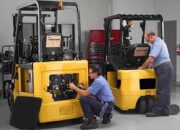Maintenance manual for diesel forklifts
The maintenance cycle of diesel forklifts is daily maintenance, i.e. daily maintenance and pre-startup inspection of the forklift. The first level maintenance period is the cumulative operation of the diesel engine for 150 hours. If an internal combustion forklift’s annual service life is less than 150 hours, level one maintenance is performed once a year. Forklift level 2 maintenance intervals are 450 hours, and forklifts with less than 450 hours of service life will require secondary maintenance every three years.
The maintenance items for diesel forklift trucks are as follows:
1. Periodic maintenance of diesel forklifts
Routine maintenance is that the driver cleans, inspects and debugs during each shift. It is the main daily maintenance item of vehicle exterior cleaning, and is an important basis for forklift maintenance. The main tasks of this maintenance are: removing dirt from the forklift, checking and replenishing engine coolant, lubricating oil and fuel, draining water from the cooling system at low temperatures, checking check the tightness of connectors of various forklift parts, etc. The details of the daily forklift maintenance process are as follows:
1) Clean dirt, mud on the forklift and important components such as fork frame and slide, generator and starter, battery water, water tank and air filter.
2) Check the tightening conditions of the various parts, focusing on the fork frame parts, the chain tensioner screws, the wheel screws, the wheel fixing pin, the brake and the rudder screw.
3) Check the reliability and flexibility of foot brake and steering mechanism.
4) Leak test, focusing on each pipe joint, diesel tank, oil tank, brake pump, lifting cylinder, tilt cylinder, water tank, water pump, engine oil pan, torque converter, gearbox, shaft transmission, main reducer, gear hydraulic steering, steering cylinder.
5) Remove dirt from the oil filter.
6) Check the working conditions of tools, lights, horns, etc.
7) After completing the above checks, start the machine, check the operation of the engine, check the transmission system, brake system and hydraulic lifting system for normal operation.
2. What does the maintenance of a diesel forklift need to do?
Level one diesel forklift maintenance is a routine item that focuses on cleaning, tightening, and lubrication. In addition to other tasks requiring routine maintenance, it is mainly necessary to replenish and replace the lubricating oil (grease) for the specified parts. Besides, carefully inspect, debug and replace the wearable parts on the forklift locally. The main content of the technical maintenance of level 1 forklifts is as follows:
1) Check cylinder pressure or vacuum: check and adjust valve clearance, check thermostat is working properly.
2) Check that the multi-way pump reversing valve, lifting cylinder, tilting cylinder, steering cylinder and gear pump are working properly.
3) Check if the gear shift is normal: check and adjust the clearance between the brake pads of the handbrake, foot brake and brake drum.
4) Change the oil in the oil pan, check if the crankcase ventilation pipe is good, and clean the filter element of the washing machine oil filter and the diesel oil filter.
5) Check that the alternator and starter installation is secure, that the connectors are clean and secure, and also check the wear of the brushes and the commutator.
6) Check the tightness of the fan drive belt.
7) Check that the wheel installation is secure, that the tire air pressure is satisfactory, and that the dirt is removed from the tire.
8) If parts are disassembled due to maintenance work, a road test of the forklift should be carried out after reassembly.
– Check brake performance at different levels, there should be no deflection and meandering. On steep slopes, the handbrake is applied for reliable parking.
– Hear any abnormal sounds when the engine is running under acceleration, deceleration, heavy load or no-load conditions.
– After a test run, check the brake, transmission, front axle housing and gear pump for overheating.
– Check if the lifting speed of the fork frame is normal and not shaken.
9) Check whether the filter mesh at the oil inlet of the diesel pump is clogged or damaged, and clean or replace the filter.
3. Level three diesel forklift maintenance
Level 3 maintenance is maintenance repair. In addition to completing the work specified in the first level maintenance, the focus of the second level maintenance should be on the natural wear patterns of the components and on failures or indications found in the process. targeted local disassembly and commissioning process. Repair or replace to eliminate local damage to the forklift due to natural wear and tear of parts or from improper maintenance and operation of a diesel forklift. It is mainly based on inspection, adjustment and prevention, mainly disassemble, inspect, clean, change oil, summer repair or replace vulnerable oversized parts







